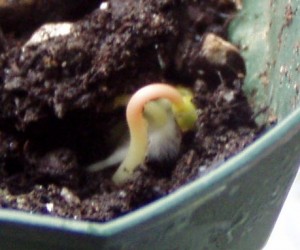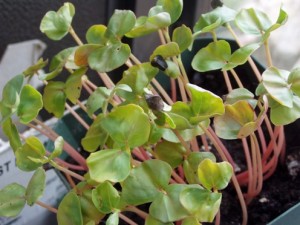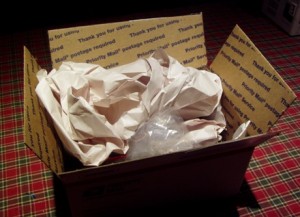 For those of you who are in Zone 5 and higher, my situation really does not fit. I’m sure you’ve been planting out in your gardens for weeks, if not the last month or so. And for those folks in Zone 7 or 8, you are coming to the end of your winter growing season, I’m sure!
For those of you who are in Zone 5 and higher, my situation really does not fit. I’m sure you’ve been planting out in your gardens for weeks, if not the last month or so. And for those folks in Zone 7 or 8, you are coming to the end of your winter growing season, I’m sure!
But, for people like your dear Aunty, who grow in ‘Zone 4 which is really Zone 2’, things are still very chancy, even for cold weather crops. We had a couple of very warm days last weekend, which put the soil temperature way up, but I knew it would not last. Since we were slated to get rain (which we did, day after day after day), I uncovered the beds that I’d put under plastic so that they’d get a good drink and then I covered them back up again to get some solar gain.
Sometimes, people ask me whether putting plastic (or glass as I’ve done before) really is worth it. Well, this morning, after running errands, I went out and took the temperature of the end of the bed that didn’t get covered with the plastic. It was 44.3 degrees F. Too cold to plant anything in. Under the plastic, it was 50.1 degrees F. Marginally ready to put in seeds for plants such as lettuce, cabbage, cauliflower, broccoli, Chinese cabbage and so on. I’ll give it one more week. We’re supposed to have a couple of very sunny days in the low 60-degree range, which should bring that area under the plastic into a solid mid-50 degrees which will be plenty safe for sowing those seeds.
But I’d like you to notice the difference. Not under the plastic: 44.3 degrees F. Under the plastic: 50.1 degrees F. At this point in the spring, that’s a lot of temperature difference so I have to say it is definitely worth it since I’ll be able to put in those seeds now, in April, instead of late May otherwise. So, I’ve gained 6 weeks on my growing season. Definitely worth it.
The photo at the top is of some buckwheat seeds I gave to my grandson to plant in a pot as a little activity this past week. He planted them on Tuesday. I put them into a plastic bag on top of a heating pad covered with an old towel in the green house. That photo was taken on Thursday.
48 hours, some dirt, some moisture and some heat and up they come. But wait until you see the next photo: This photo was taken on Saturday!! So, there you are – in terms of buckwheat, as long as you’ve got warmth in the soil and some moisture, they are up and running fast, which is the reputation of this plant, since the directions literally tell you that if you are not interested in growing buckwheat for seed (that is, to harvest seed for eating or saving), you need to be cutting it down and digging it into the soil in less than 6 weeks, when it will be flowering. This past week, when we had those sunny days, I sowed one whole bed under the plastic with buckwheat seeds to start the soil improvement process. That bed was created last year and we did not have proper compost to do it. We used compost from the county landfill which frankly was mostly rotted wood chips. It was awful and the tomato plants we put into it showed the lack of soil and lack of nutrients – they frankly crouched on the ground. It was a waste of time to put anything in there. I should have done then what I’m doing this spring – put in buckwheat and when it’s up, cut it down and dig it into the bed, then water well and sow more buckwheat seed. In a couple of months, I’ll have a lot better bed than I do now and I’ll be able to put something else in there in June and July, whether that is a crop of beans, or cabbage family plants for the fall.
So, there you are – in terms of buckwheat, as long as you’ve got warmth in the soil and some moisture, they are up and running fast, which is the reputation of this plant, since the directions literally tell you that if you are not interested in growing buckwheat for seed (that is, to harvest seed for eating or saving), you need to be cutting it down and digging it into the soil in less than 6 weeks, when it will be flowering. This past week, when we had those sunny days, I sowed one whole bed under the plastic with buckwheat seeds to start the soil improvement process. That bed was created last year and we did not have proper compost to do it. We used compost from the county landfill which frankly was mostly rotted wood chips. It was awful and the tomato plants we put into it showed the lack of soil and lack of nutrients – they frankly crouched on the ground. It was a waste of time to put anything in there. I should have done then what I’m doing this spring – put in buckwheat and when it’s up, cut it down and dig it into the bed, then water well and sow more buckwheat seed. In a couple of months, I’ll have a lot better bed than I do now and I’ll be able to put something else in there in June and July, whether that is a crop of beans, or cabbage family plants for the fall.
Let’s see now. In our greenhouse (which is unheated – I use heating mats with grids over them for the seedlings to stay warm inside their huge clear plastic bags), the pepper and tomato seedlings have had to be moved to larger quarters, and I also sowed a flat of a mix of basil seeds I got from Pinetree Seeds Pinetree Garden Seeds. One of the things I especially like about this company (besides the fact that it is locally owned, not part of a conglomerate, and they offer an amazing array of vegetable seeds from all over the world) is that they offer mixes of things. I don’t have that large a garden, so buying three or four different packets of any particular thing is not cost effective for me. But we use basil in cooking a lot, so I grow a lot, and like different types for different reasons, so having a packet of a mix of basil is a great thing for me. They offer mixes of seeds for almost all of their veggies so, if you want to try something new, I recommend you take a look.
Another change this year is that our grandson is now at the age where we can start inculcating (woops – introducing him might be a better word) him about the wonders of gardening (hence the handful of buckwheat seeds in the pot of soil). I showed him a seed catalog and we went through it, identifying the various vegetables and talking about what he’d like to grow in ‘his’ garden – I figure one little 3-4 foot end of a bed will work for one tomato plant, one pepper plant, a marigold (got to have flowers in every garden, right?) and a handful of beans. I always feel that little kids get some of their best introductions to new veggies when they are in the garden and can pick, snip and pull them up by themselves. Who knows, perhaps he’ll learn to like kohlrabi and parsnips this year?

